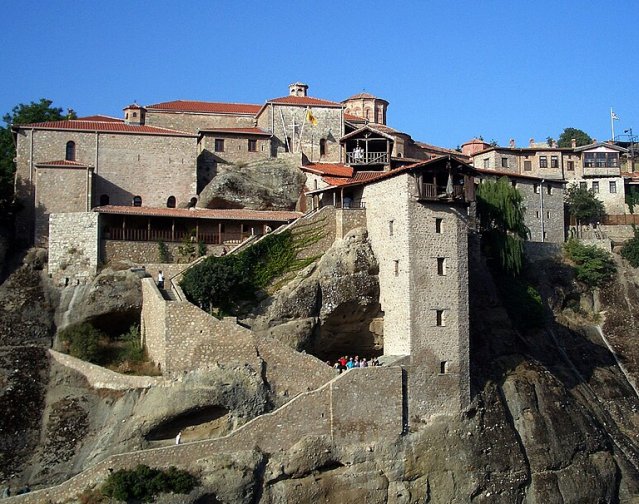MEGALO METEORO and VARLAAM ...
The monastery MEGALO METEORO
The Monastery of the Transfiguration of the Saviour, also known as Megalo Meteoro, is a male monastery located on the highest point of Meteora at an altitude of 534 metres. It is the largest of the six monasteries still active in Meteora, which has been a UNESCO World Heritage Site since 1988. It was founded in the 14th century by St Athanasius of Meteora and experienced its heyday in the mid-16th century. The monastery is located on the summit of Platys Lithos and can be reached via a staircase.
The monastery was founded in the first half of the 14th century as the skete of Agios Athanasius of Meteora. Athanasius built a church dedicated to the Virgin Mary, which became known as the Virgin of Meteoritissa Petra, and founded a monastic community in the form of a commune. His pupil John Uresis Palaiologos, who called himself Osios Ioasaph, built a new monastery on the site of the church in 1387/88. The monastery was granted privileges and full independence by Patriarch Jeremias I, like the monasteries on Mount Athos. In 1544/5, a new church dedicated to the Transfiguration of the Saviour was built on the initiative of Abbot Simeon. The tower was also built in the same period and the courtyard was constructed in 1572. New cells were built in 1806.
Near the entrance to the monastery are the tower, which housed the net mechanism, and the monastery cellar (a wine cellar), which now serves as a museum with everyday artefacts. Next are the dormitory, the refectory, the hospital and the nursing home to the east and the catholicon on the right. Next to the platform of the sanctuary is the domed chapel of Timios Prodromos and, to the south-west, the one-room chapel of St Constantine and St Helen, built in 1789.
In the years 1961-1973, the monastery was led by the Asia Minor abbot Emilianos Simonopetritis, who contributed to the spiritual renaissance of Meteora.
 |
 |
The monastery MEGALO METEORO The VARLAAM monastery
The VARLAAM monastery
The monastery of Varlaam, or the Monastery of All Saints, is a monastery for men located on a steep cliff. It is one of the six monasteries still active in Meteora, which has been a UNESCO World Heritage Site since 1988. The monastery was founded at the beginning of the 16th century, but takes its name from the ascetic Varlaam, who settled on the rock in the 14th century. It is known for the important archives it holds. The monastery was founded at the beginning of the 16th century by the brothers Nektarios and Theophanes, the so-called Apsarades, from Epirus. In 1518, they renovated the Chapel of the Three Hierarchs, which had been built by Barlaam. In 1536, the tower of Brizonios was built. The monastery experienced economic growth and spiritual prosperity.The catholicon of the monastery, which is dedicated to all the saints, is in the shape of a cross and is of the Athonite type and dates back to 1541. Its hagiography was carried out in three phases. The oldest paintings were made by Frangos Catellano in 1548. The second phase dates from 1566 and is the work of the hagiographers Georgios and Fragos Kontaris. According to a cadastral inscription, the most recent hagiographies date from 1780 and 1782, but were probably minor interventions. To the north-west of the catholicon is the refectory, which houses relics, the chapel of the Three Hierarchs, a one-room wooden dromos, the hearth, the cells and the guest house. On the other side, towards the entrance, are the hospital and the Agion Anargyron chapel.